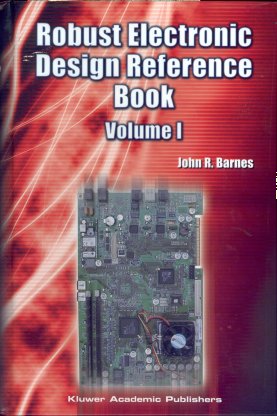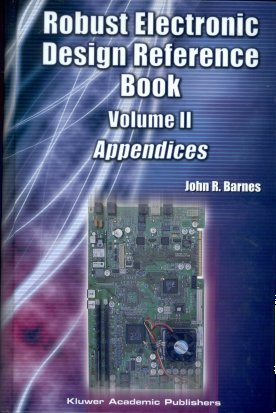This web site is being maintained by John R. Barnes, who was the President
and Chief Engineer of dBi Corporation from 2002 to September 30, 2013,
when we closed because ObamaCrap made it too expensive for us to remain in
business.
John R. Barnes KS4GL, PE, NCE, NCT, ESDC Eng, ESDC Tech, PSE, Master EMC
Design Engineer, SM IEEE
February 5, 2021
jrbarnes@iglou.com
This web site is intended to help you develop electronic products and
electronic equipment that:
- Work.
- Are safe and reliable.
- Can be manufactured, tested, repaired, and serviced
economically.
- May be marketed and used worldwide, meeting national
and international:
- Product safety standards.
- Electromagnetic compatibility (EMC) standards.
- Electromagnetic interference (EMI) standards.
- Electrostatic discharge (ESD) standards.
- Can be easily enhanced/adapted to meet new and
changing market requirements.
The following web pages are new, or have had significant
content added within the last month:
- Bibliography for Designing Lead-Free,
RoHS-Compliant, and WEEE-Compliant Electronics (revised February 5,
2021)
- Bibliography for Tin Whiskers, Zinc Whiskers,
Cadmium Whiskers, Indium Whiskers, and Other Conductive Metal and
Semiconductor Whiskers (revised February 5, 2021)
- Bibliography for Tin Whiskers (revised February
5, 2021)
- Tin Pest (revised February 5, 2021)
- Power Distribution on Printed Circuit Boards-
Bibliography (revised February 5, 2021)
- Designing Electronic Equipment for ESD Immunity-
Annotated Bibliography (revised February 4, 2021)
John R. Barnes' second and third books,
Robust Electronic
Design Reference Book, Volumes I and II are now available from
Springer, which merged with
Kluwer Academic Publishers in July 2004. The ISBN for the hardbound set is
1-4020-7739-4, and the list price is $495.00 (US)-- although you can now find
it for considerably less on the Internet. The two books total 1,736
pages, with 194 tables, 663 illustrations, and a 106-page index covering over
9,200 design/ development/ manufacturing problem areas that may arise in
getting from that "first fuzzy idea" to a product in mass production, or a
piece of equipment in service. In 2005, John received a Division Technical
Achievement Award from the
ARRL for writing these books. You can
read a sample chapter by going to
Chapter 17. Further information on these books is available at:



John's most recent article,
"Designing Electronic
Systems for ESD Immunity", was published in the February 2003
Conformity magazine
(vol. 8 no. 1, pages 18-27). This is a condensed version of his two-part
article
"Designing Electronic
Equipment for ESD Immunity" which was published in the July 2001
Printed Circuit Design magazine (vol. 18 no. 7, pages 18-26) and
"Designing Electronic
Equipment for ESD Immunity Part II," which appeared on the
pcdmag.com web site in November 2001.
This web site may be accessed through
http://www.dbicorporation.com/.
The first major section of this website is devoted to
designing electronic products and equipment that are safe and reliable:
The second major section of this website is devoted to
designing electronic products and equipment that can be manufactured, tested,
repaired, and serviced economically:
The third major section of this website is devoted to designing electronic
products and equipment that may be marketed and used worldwide:
- Bibliography of EMC/EMI/ESD Standards for
Information Technology Equipment (ITE) and Related (Generic)
Equipment (revised May 10, 2012)
- Emissions Standards for Commercial Electronic
Products (Unintentional Radiators) (revised December 2, 2011)
- Immunity Standards for Commercial Electronic
Products (revised December 2, 2011)
- Harmonics Standards for Commercial Electronic
Products (revised December 2, 2011)
- Flicker Standards for Commercial Electronic
Products (revised December 2, 2011)
- Electrostatic Discharge (ESD) Standards for Commercial
Electronic Products (revised December 3, 2011)
- Radiated Immunity Standards for Commercial
Electronic Products (revised December 3, 2011)
- Electrical Fast Transient/Burst (EFTB) Standards for
Commercial Electronic Products (revised December 3, 2011)
- Surge Immunity Standards for Commercial Electronic
Products (revised December 2, 2011)
- Conducted Immunity Standards for Commercial
Electronic Products (revised December 3, 2011)
- Magnetic Field Immunity Standards for Commercial
Electronic Products (revised December 3, 2011)
- Voltage Dip/Voltage Interruption Standards for
Commercial Electronic Products (revised December 3, 2011)
- EMC/EMI/ESD Standards for Commercial Electronic
Products (revised December 4, 2011)
- Key Dates for EMC/EMI/ESD Standards for
Commercial Electronic Products (revised December 11, 2011)
- EMC/EMI/ESD Standards for Information Technology
Equipment (ITE) (revised December 19, 2010)
- EMC/EMI/ESD Standards for Radio and Television
Broadcast Receivers, and Associated Equipment (revised December 19,
2010)
- EMC/EMI/ESD Standards for Measurement, Control, and
Laboratory Equipment (revised December 19, 2010)
- EMC/EMI/ESD Standards for Lamps and Luminaires
(revised December 19, 2010)
- EMC/EMI/ESD Standards for Household Electrical
Appliances and Portable Tools (revised December 19, 2010)
- EMC/EMI/ESD Standards for Generic Products to be
Used in Residential, Commercial, and Light- Industrial Environments
(revised December 19, 2010)
- EMC/EMI/ESD Standards for Generic Products to be
Used in Industrial Environments (revised December 19, 2010)
- Internet Sources for Electronics Books, Standards,
Manuals, Journals, and Magazines (revised June 26, 2012)
- Transition Rules and EMC/EMI/ESD Test-Report
Retention Rules (revised December 19, 2010)
The fourth major section of this website is devoted to designing electronic
products and equipment that can be easily enhanced/adapted to meet new and
changing market requirements
- International Power, Plugs, and
Languages (revised December 21, 2010, 38KB, 9 pages)
- International Primary Power, Plugs,
Languages, Approval Marks, and Approval Agencies (revised December 31,
2010, 190KB, 70+ pages)
The fifth major section of this website is devoted to designing electronics to
be lead-free, RoHS-compliant, and WEEE-compliant:
- Bibliography for Designing Lead-Free,
RoHS-Compliant, and WEEE-Compliant Electronics (revised February 5,
2021)
- Bibliography for Tin Whiskers (revised February
5, 2021)
- Bibliography for Tin Whiskers, Zinc Whiskers,
Cadmium Whiskers, Indium Whiskers, and Other Conductive Metal and
Semiconductor Whiskers (revised February 5, 2021)
- Tin Pest (revised February 5, 2021)
- RoHS Compliance: THE END of Reliable Electronics?
(presented to the Lexmark Toastmasters Club on May 17, 2005; added
January 27, 2006)
- Lead-Free Electronics and the RoHS Directive
(presented to the Lexington Section of the IEEE on January 26, 2005;
added January 27, 2006)
- Power Distribution on Printed Circuit Boards-
Bibliography (revised February 5, 2021)
- Tin Whisker Group Teleconferences (revised
March 15, 2018)
The sixth major section of this website is devoted to Robust
Electronic Design Reference Book, Volumes I and II:
- Corrections, Updates, and Additions to Robust
Electronic Design Reference Book, Volumes I and II (revised February 6,
2012)
- Robust Electronic Design Reference Book, Volumes
I and II(revised December 19, 2010)
- 20 line/inch graph paper for drawing line art
using Microsoft Word 97's drawing features (View, Toolbars, Drawing)
(added January 11, 2004)
- schematic symbols for drawing line art using
Microsoft Word 97's drawing feature (added January 11, 2004)
- Using PE32 to Create an Index for Microsoft Word
(and Other) Documents (revised December 20, 2010)
The last major section of this website is devoted to miscellaneous topics:
We would appreciate your suggestions for additional topics of concern to you.
Please E-mail us at jrbarnes@iglou.com,
or call us at (859)253-1178.
DISCLAIMER
These documents are freely offered to anyone who wishes to use them. No
warranty for their use is expressed or implied. The information in these
documents is believed to be correct, because they are based on primary source
documents as much as possible. But some of these documents are known to be
incomplete, because we are still in the process of finding pertinent source
material, and because standards/regulations in their areas are continuously
evolving.
Please use these documents as:
- Pointers to official documents that may pertain to your product(s).
- Reminders of problem areas and pitfalls that you may encounter in
designing electronic products.
- Some guidelines to help you avoid or work around these problem areas.
No amount of reading can take the place of having experienced personnel,
armed with the pertinent information, designing or reviewing the design of
your particular product.
COMMENTS
If you refer to one or more of these documents in written communications,
please mention our web site as the source. Similarly, if you link to them
from your own web page(s), please E-mail
jrbarnes@iglou.com giving the
universal resource locater (URL), so that we may provide a reciprocal link.
Please send critiques, corrections, and/or additions to
jrbarnes@iglou.com , or
by snailmail to:
John Barnes
216 Hillsboro Ave
Lexington, KY 40511-2105
dBi Corporation was a
one-man test house (testing laboratory) based in Lexington, Kentucky, testing
a wide variety of commercial electronic products for electromagnetic
compatibility (EMC), electromagnetic interference (EMI), and electrostatic
discharge (ESD) under its ISO 17025 accreditation. dBi was founded in
Winchester, Kentucky in 1995 by Donald R. Bush, shortly after he retired from
30 years service with IBM Lexington's/ Lexmark's EMC Lab. John R. Barnes,
who'd worked with Don at IBM Lexington and Lexmark, bought dBi in 2002
after Don's death, and moved the company to Lexington, Kentucky. John closed
dBi at 11:59pm EDT on September 30, 2013, because ObamaCrap had
increased operating expenses to the point that we could no longer afford to
remain in business.
We'd like to thank all of the clients who chose dBi to test their
products from 1995 to 2013. Below is a brief summary of our accomplishments
during the 18 years we were in business.
From 1995 to 2001, under Don Bush's ownership and operation, dBi:
- Did the official approval testing of 141 products developed by 20
client companies.
- Did the official FCC/ Industry Canada (IC) Verification and Declaration
of Conformity (DoC) testing of 92 products.
- Did the official FCC/IC Certification testing of 15 products.
- Did the official CE Marking testing of 100 products.
From 2002 to 2013, under John Barnes' ownership and operation, dBi:
- Tested 389 products and 2 testers developed by 44 client companies.
- Did the official approval testing of 357 products and 2 testers, getting
all but 4 of them to meet all of the FCC, Industry Canada
(IC), CE Marking, C-Tick, and Regulatory Compliance Mark (RCM) standards
and requirements for their desired market areas.
- Did the official FCC/IC Verification and Declaration of Conformity (DoC)
testing of 296 products.
- Did the official FCC/IC Certification testing of 24 products.
- Did the official CE Marking testing of 271 products and 2 testers.
- Did the official e-Mark testing of 3 products.
- Did the official Australia/New Zealand Verification testing of 170
products.
- Co-sponsored John's writing the
Robust Electronic Design Reference Book,
Volumes I and II.
- Served as an expert witness on electronics in three lawsuits.
Last revised February 5, 2021



